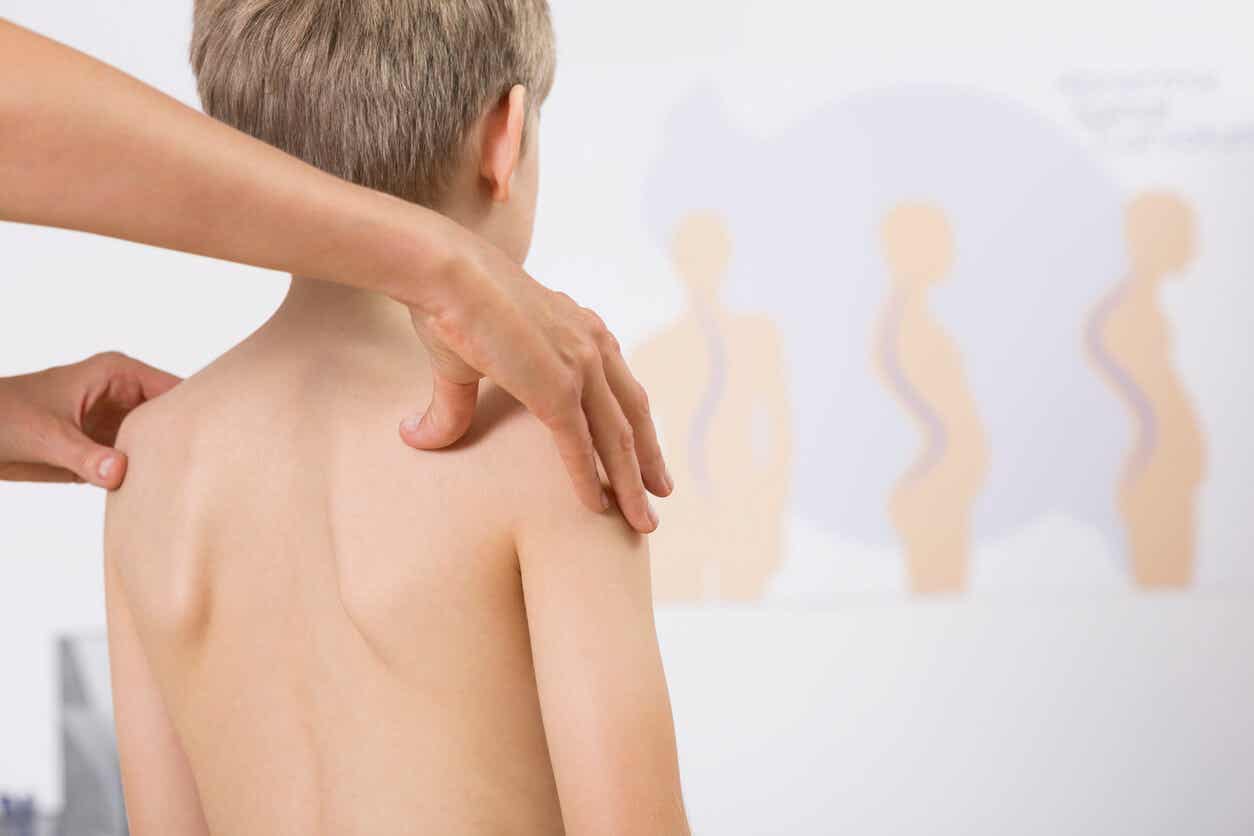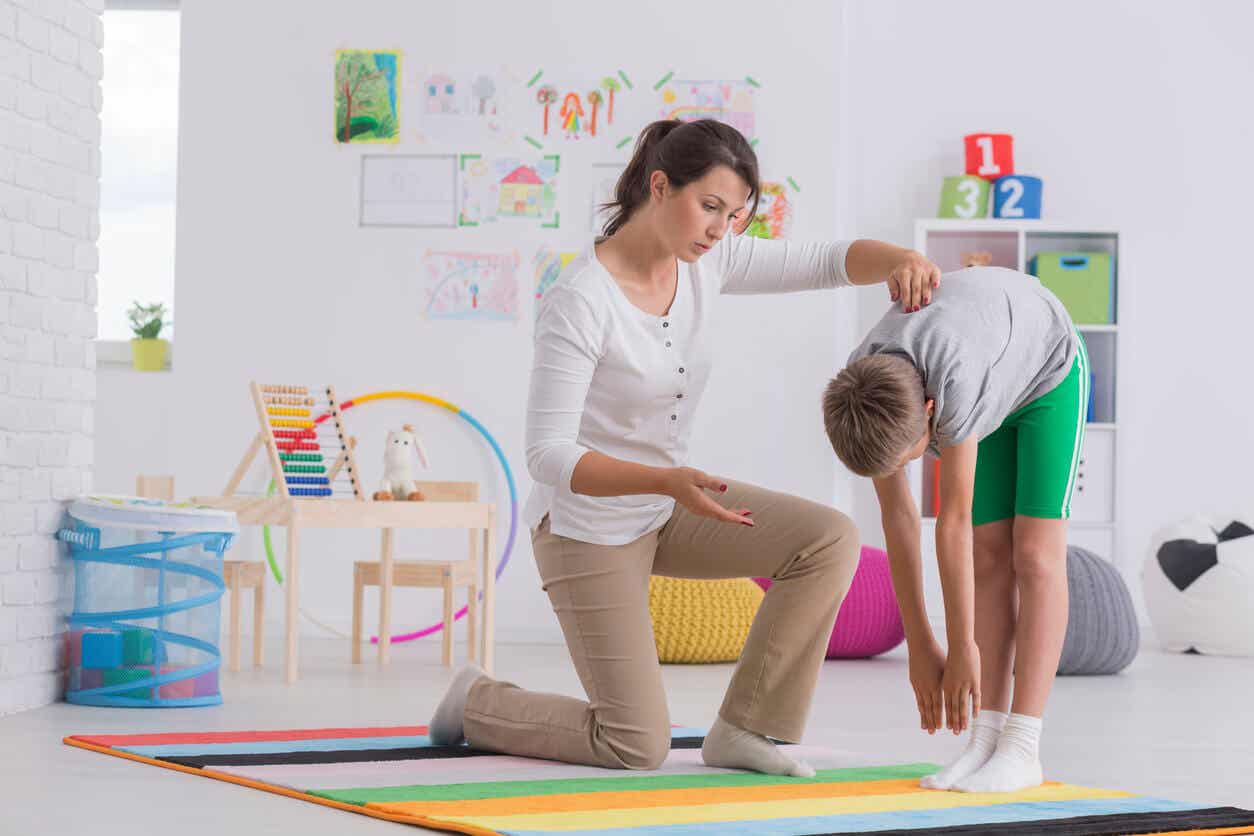The Treatment of Scoliosis in Children

Ideally, the treatment of scoliosis in children takes place only after carrying out a careful physical examination. Besides that, it’s important to carry out specific tests to obtain a better diagnosis. Furthermore, specialists should monitor the patient during their developmental stage.
It’s very important to examine and detect possible deformities in the spinal cord from an early age. Children’s bodies are quite flexible and they tend to adapt as time goes by. However, the curves produced by scoliosis may become more notorious, depending on each case.
The treatment of scoliosis in children can be conservative, orthotic, or surgical, depending on the seriousness of the case. Sometimes, specialists combine different treatments for better results.

What is scoliosis?
Scoliosis is a deformity of the backbone. It includes an alteration of the alignment of the vertebra in the three planes of motion. Therefore, the backbone not only bends to one side or the other, but it also may cause the vertebrae to rotate.
These curvatures may be the result of many different causes. In some cases, they happen from the day babies are born. Other times, they may result from trauma or surgical intervention. And, finally, they may exist due to neurological disorders. However, most of the time, we’re looking at idiopathic scoliosis, because there’s no definite cause. Notwithstanding, the different types are usually related to the different growth stages. This is why they may be called childhood or adolescent scoliosis.
How can we identify scoliosis in children?
It’s possible to identify scoliosis in children after carrying out different tests in which doctors analyze children’s static and dynamic postures. Through these different tests, it’s possible to assess the backbone in motion. As a result, it’s possible to identify whether these deformities relate to a scoliotic posture or scoliosis.
In addition, specialists ask for complementary tests, such as X-rays. This test allows doctors to observe the whole backbone and to measure the curves of the vertebra. The results of these measurements are angle values. And, they help us identify the curvature or rotation degree of the vertebra. Therefore, this method is used to determine the seriousness of the deformity.
On the other hand, magnetic resonance imaging and CAT scans are only carried out in case of more serious situations or if there’s a possibility of other related diseases.
A test of a child who suffers from scoliosis shows signs of asymmetry at the shoulders area. Besides, you can notice a difference in the shape of the waist and the inner part of the arms. Moreover, there’s a possibility of children having one shoulder blade more prominent than the other. However, it’s important to dismiss other diseases that may cause these deformities.
The treatment of scoliosis in children
After carrying out a complete physical examination and complementary tests, it’s time to choose the best treatment of scoliosis in children. Of course, it’ll depend on the age of the child, the evolution, and the seriousness of the curvature. Finally, another aspect to take into account is the cause of the deformity and the prognosis, according to each patient’s case.
All this information will allow doctors to identify whether they’re dealing with a case of structural or functional scoliosis. In the case of functional scoliosis, it’s possible to fix it by reverting the cause or correcting bad posture or muscle contraction.

- Conservative treatment: This is the first choice in the case of mild and moderate situations. Conventional physiotherapy includes manual techniques, flexibility exercises, and muscle strengthening. Furthermore, there are other special therapies, like postural rehab and osteopathy, which seem to be quite effective. Practicing Pilates exercises can be very effective, too.
- Orthotic treatment: If the design of the corset is correct, it might be quite effective in reducing the evolution of the curvature. However, it’s important to combine this treatment with exercises from a physiotherapist in order to prevent side effects from not moving the back. This is not a good treatment in the case of extremely mild cases, because a conservative treatment would probably be enough. Moreover, if the patient already needs surgery, this wouldn’t be necessary, either. Finally, it’s worth mentioning that it can be quite an annoying device and teenagers usually don’t want to wear it.
- Surgery: This treatment is for more severe cases when the other treatments don’t seem to be enough. When programming a spine surgery, doctors must consider the type of curvature and its possible evolution. In addition, physiotherapy treatment can be useful before going on surgery.
The sooner children start the treatment, the more effective it will be
Regular check-ups should include backbone examinations. Furthermore, parents should pay attention to their children’s posture as they grow older. In case you notice an alteration in their spine, you can visit the doctor.
Scoliosis treatment in children has better results if you start once the curvature first appears. Depending on the cause, if time goes by, it might become more complicated to fix. Therefore, it’s extremely important to visit the doctor regularly and to take care of your children’s posture.
Ideally, the treatment of scoliosis in children takes place only after carrying out a careful physical examination. Besides that, it’s important to carry out specific tests to obtain a better diagnosis. Furthermore, specialists should monitor the patient during their developmental stage.
It’s very important to examine and detect possible deformities in the spinal cord from an early age. Children’s bodies are quite flexible and they tend to adapt as time goes by. However, the curves produced by scoliosis may become more notorious, depending on each case.
The treatment of scoliosis in children can be conservative, orthotic, or surgical, depending on the seriousness of the case. Sometimes, specialists combine different treatments for better results.

What is scoliosis?
Scoliosis is a deformity of the backbone. It includes an alteration of the alignment of the vertebra in the three planes of motion. Therefore, the backbone not only bends to one side or the other, but it also may cause the vertebrae to rotate.
These curvatures may be the result of many different causes. In some cases, they happen from the day babies are born. Other times, they may result from trauma or surgical intervention. And, finally, they may exist due to neurological disorders. However, most of the time, we’re looking at idiopathic scoliosis, because there’s no definite cause. Notwithstanding, the different types are usually related to the different growth stages. This is why they may be called childhood or adolescent scoliosis.
How can we identify scoliosis in children?
It’s possible to identify scoliosis in children after carrying out different tests in which doctors analyze children’s static and dynamic postures. Through these different tests, it’s possible to assess the backbone in motion. As a result, it’s possible to identify whether these deformities relate to a scoliotic posture or scoliosis.
In addition, specialists ask for complementary tests, such as X-rays. This test allows doctors to observe the whole backbone and to measure the curves of the vertebra. The results of these measurements are angle values. And, they help us identify the curvature or rotation degree of the vertebra. Therefore, this method is used to determine the seriousness of the deformity.
On the other hand, magnetic resonance imaging and CAT scans are only carried out in case of more serious situations or if there’s a possibility of other related diseases.
A test of a child who suffers from scoliosis shows signs of asymmetry at the shoulders area. Besides, you can notice a difference in the shape of the waist and the inner part of the arms. Moreover, there’s a possibility of children having one shoulder blade more prominent than the other. However, it’s important to dismiss other diseases that may cause these deformities.
The treatment of scoliosis in children
After carrying out a complete physical examination and complementary tests, it’s time to choose the best treatment of scoliosis in children. Of course, it’ll depend on the age of the child, the evolution, and the seriousness of the curvature. Finally, another aspect to take into account is the cause of the deformity and the prognosis, according to each patient’s case.
All this information will allow doctors to identify whether they’re dealing with a case of structural or functional scoliosis. In the case of functional scoliosis, it’s possible to fix it by reverting the cause or correcting bad posture or muscle contraction.

- Conservative treatment: This is the first choice in the case of mild and moderate situations. Conventional physiotherapy includes manual techniques, flexibility exercises, and muscle strengthening. Furthermore, there are other special therapies, like postural rehab and osteopathy, which seem to be quite effective. Practicing Pilates exercises can be very effective, too.
- Orthotic treatment: If the design of the corset is correct, it might be quite effective in reducing the evolution of the curvature. However, it’s important to combine this treatment with exercises from a physiotherapist in order to prevent side effects from not moving the back. This is not a good treatment in the case of extremely mild cases, because a conservative treatment would probably be enough. Moreover, if the patient already needs surgery, this wouldn’t be necessary, either. Finally, it’s worth mentioning that it can be quite an annoying device and teenagers usually don’t want to wear it.
- Surgery: This treatment is for more severe cases when the other treatments don’t seem to be enough. When programming a spine surgery, doctors must consider the type of curvature and its possible evolution. In addition, physiotherapy treatment can be useful before going on surgery.
The sooner children start the treatment, the more effective it will be
Regular check-ups should include backbone examinations. Furthermore, parents should pay attention to their children’s posture as they grow older. In case you notice an alteration in their spine, you can visit the doctor.
Scoliosis treatment in children has better results if you start once the curvature first appears. Depending on the cause, if time goes by, it might become more complicated to fix. Therefore, it’s extremely important to visit the doctor regularly and to take care of your children’s posture.
All cited sources were thoroughly reviewed by our team to ensure their quality, reliability, currency, and validity. The bibliography of this article was considered reliable and of academic or scientific accuracy.
- Albor Barraza, Carolay Isabel, Yaletza Carolina Díaz Escalante, and Wendy Vanesa Vergara Aron. “Fisioterapia basada en la evidencia para el tratamiento en adultos y niños con escoliosis funcional.” (2017). https://repositorio.udes.edu.co/handle/001/5016
- Andrés Alcoceba, Rafael. “Estudio del método Pilates como tratamiento de la Escoliosis Idiopática en población infantil. Revisión narrativa.” (2017). https://uvadoc.uva.es/handle/10324/26693
- SALDAÑA MURILLOS, ESTIBALIZ YERALDINE. “Pie plano y su relación con la escoliosis en niños del hospital III EsSalud Chimbote, 2017.” (2019). http://200.48.38.121/handle/USANPEDRO/12035
- Salinas, Pedro A. Martínez, et al. “Evolución clínica posterior a tratamiento de escoliosis congénita y múltiples malformaciones óseas: reporte de caso en un gemelo dicigótico.” Revista Mexicana de Ortopedia Pediátrica 20.1 (2018): 49-55. https://www.researchgate.net/profile/Nina-Mendez/publication/328724326_Evolucion_clinica_posterior_a_tratamiento_de_escoliosis_congenita_y_multiples_malformaciones_oseas_reporte_de_caso_en_un_gemelo_dicigotico/links/5bddd1f14585150b2b9d38e3/Evolucion-clinica-posterior-a-tratamiento-de-escoliosis-congenita-y-multiples-malformaciones-oseas-reporte-de-caso-en-un-gemelo-dicigotico.pdf
- Bermeo Taramuel, Katherine Jackeline, and Karla Maholy Gaybor Chancay. Prevalencia de la escoliosis idiopática en adolescentes. Diss. Universidad de Guayaquil. Facultad de Ciencias Médicas. Carrera de Medicina, 2019. http://repositorio.ug.edu.ec/handle/redug/43934
- Burga Castro, Julissa del Carmen. “Tratamiento fisioterapéutico en escoliosis en S compensada.” (2020). http://repositorio.uigv.edu.pe/handle/20.500.11818/5142
This text is provided for informational purposes only and does not replace consultation with a professional. If in doubt, consult your specialist.








